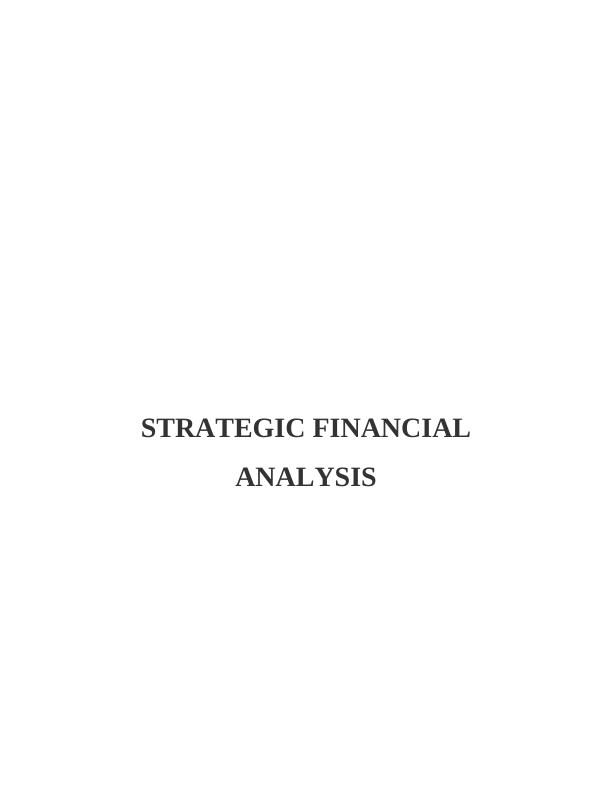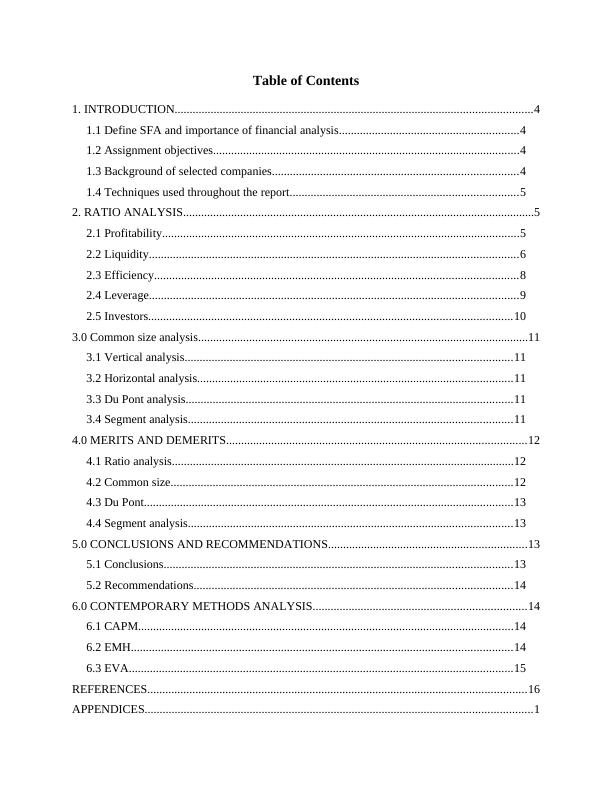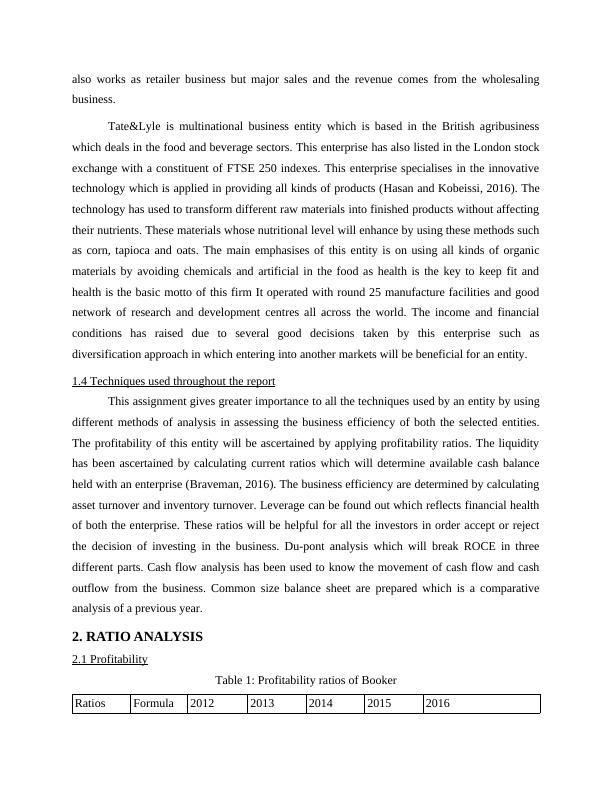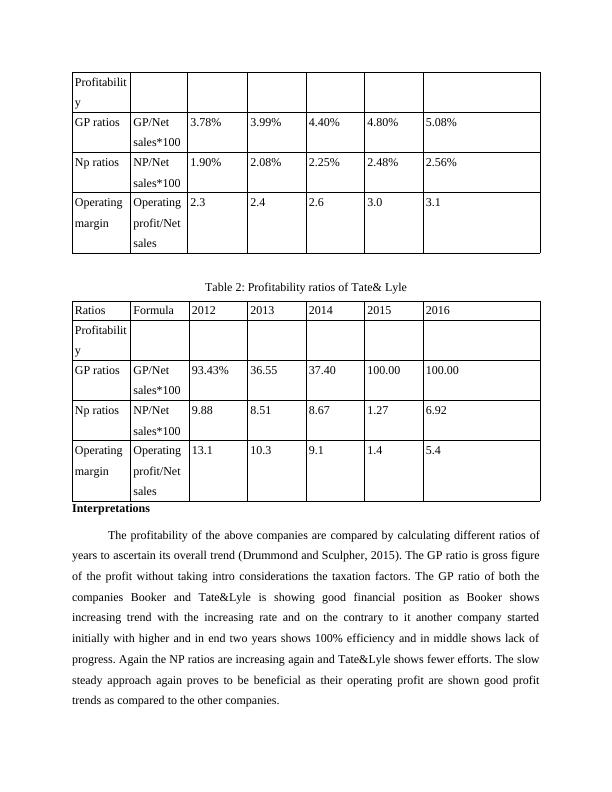Importance of Strategic Financial Analysis (SFA)
Added on 2020-02-03
22 Pages5476 Words180 Views
STRATEGIC FINANCIALANALYSIS

Table of Contents1. INTRODUCTION.......................................................................................................................41.1 Define SFA and importance of financial analysis............................................................41.2 Assignment objectives......................................................................................................41.3 Background of selected companies..................................................................................41.4 Techniques used throughout the report............................................................................52. RATIO ANALYSIS.....................................................................................................................52.1 Profitability.......................................................................................................................52.2 Liquidity...........................................................................................................................62.3 Efficiency.........................................................................................................................82.4 Leverage...........................................................................................................................92.5 Investors.........................................................................................................................103.0 Common size analysis..............................................................................................................113.1 Vertical analysis.............................................................................................................113.2 Horizontal analysis.........................................................................................................113.3 Du Pont analysis.............................................................................................................113.4 Segment analysis............................................................................................................114.0 MERITS AND DEMERITS....................................................................................................124.1 Ratio analysis..................................................................................................................124.2 Common size..................................................................................................................124.3 Du Pont...........................................................................................................................134.4 Segment analysis............................................................................................................135.0 CONCLUSIONS AND RECOMMENDATIONS..................................................................135.1 Conclusions....................................................................................................................135.2 Recommendations..........................................................................................................146.0 CONTEMPORARY METHODS ANALYSIS.......................................................................146.1 CAPM.............................................................................................................................146.2 EMH...............................................................................................................................146.3 EVA................................................................................................................................15REFERENCES..............................................................................................................................16APPENDICES.................................................................................................................................1

1. INTRODUCTION1.1 Define SFA and importance of financial analysisStrategic financial analysis is that approach commonly used by an entity which consistsof setting end goals and then analysing all the ways of completing the goals. It is that analysis inwhich different tools and techniques are used as personnel of this entity will use specific tacticsto reach their specific goals (Braveman, 2016). There are some importance of this analysis whichwill assists an enterprise in uplifting their existing situations. It is helpful for an entity inpreparing budgets which is basic form of financial analysis in SFA. The future upcoming cashflows are forecasted by ascertaining the present the facts and figures. This analysis is alsoresponsible for conducting price analysis in which external market forces are identified in orderto determine price of an enterprise. In the price analysis the main aim of the owner is to generatehigh sales volume at higher prices by determining the external elasticity of demand in the overallmarket. The primary objective of this assignment is to clarify the role of strategic financialanalysis by determining their importance in the current business. 1.2 Assignment objectivesTwo companies has been selected for this project report such as Booker and Tate&Lyleamong which financial comparison has been done by applying various techniques of strategicfinancial analysis. Financial ratios has been calculated by commenting upon the businessefficiency of 5 years in order to take further step in the business in order to select or reject thecurrent project or expanding with another business.1.3 Background of selected companiesBooker is one of the company selected for assessing its internal business functioning forthe given project (Agarwal and Green, 2016). It is one of the famous food and beverage entityoperated their business in the United Kingdom which provides their products or services as awholesaler. It deals in variety of products such as macro, booker direct, classic drinks, Rittercourivaud, chef direct, premier, family shopper in order to cater the needs of customers. It is thebiggest strengths is that current it is serving about 1.5 million customers. It is regarded as thelargest cash and carry operator in the UK which are privileged to served around 18000 productlines ranging from different price and brand ranges according to the budget of an individual. It

also works as retailer business but major sales and the revenue comes from the wholesalingbusiness.Tate&Lyle is multinational business entity which is based in the British agribusinesswhich deals in the food and beverage sectors. This enterprise has also listed in the London stockexchange with a constituent of FTSE 250 indexes. This enterprise specialises in the innovativetechnology which is applied in providing all kinds of products (Hasan and Kobeissi, 2016). Thetechnology has used to transform different raw materials into finished products without affectingtheir nutrients. These materials whose nutritional level will enhance by using these methods suchas corn, tapioca and oats. The main emphasises of this entity is on using all kinds of organicmaterials by avoiding chemicals and artificial in the food as health is the key to keep fit andhealth is the basic motto of this firm It operated with round 25 manufacture facilities and goodnetwork of research and development centres all across the world. The income and financialconditions has raised due to several good decisions taken by this enterprise such asdiversification approach in which entering into another markets will be beneficial for an entity. 1.4 Techniques used throughout the reportThis assignment gives greater importance to all the techniques used by an entity by usingdifferent methods of analysis in assessing the business efficiency of both the selected entities.The profitability of this entity will be ascertained by applying profitability ratios. The liquidityhas been ascertained by calculating current ratios which will determine available cash balanceheld with an enterprise (Braveman, 2016). The business efficiency are determined by calculatingasset turnover and inventory turnover. Leverage can be found out which reflects financial healthof both the enterprise. These ratios will be helpful for all the investors in order accept or rejectthe decision of investing in the business. Du-pont analysis which will break ROCE in threedifferent parts. Cash flow analysis has been used to know the movement of cash flow and cashoutflow from the business. Common size balance sheet are prepared which is a comparativeanalysis of a previous year.2. RATIO ANALYSIS2.1 ProfitabilityTable 1: Profitability ratios of BookerRatiosFormula20122013201420152016

ProfitabilityGP ratiosGP/Netsales*1003.78%3.99%4.40%4.80%5.08%Np ratiosNP/Netsales*1001.90%2.08%2.25%2.48%2.56%OperatingmarginOperatingprofit/Netsales2.32.42.63.03.1Table 2: Profitability ratios of Tate& LyleRatiosFormula20122013201420152016ProfitabilityGP ratiosGP/Netsales*10093.43%36.5537.40100.00100.00Np ratiosNP/Netsales*1009.888.518.671.276.92OperatingmarginOperatingprofit/Netsales13.110.39.11.45.4InterpretationsThe profitability of the above companies are compared by calculating different ratios ofyears to ascertain its overall trend (Drummond and Sculpher, 2015). The GP ratio is gross figureof the profit without taking intro considerations the taxation factors. The GP ratio of both thecompanies Booker and Tate&Lyle is showing good financial position as Booker showsincreasing trend with the increasing rate and on the contrary to it another company startedinitially with higher and in end two years shows 100% efficiency and in middle shows lack ofprogress. Again the NP ratios are increasing again and Tate&Lyle shows fewer efforts. The slowsteady approach again proves to be beneficial as their operating profit are shown good profittrends as compared to the other companies.

2.2 LiquidityTable 3: Liquidity ratio of BookerRatiosFormula20122013201420152016LiquidityCurrentratiosCurrentasset/Currentliabilities0.850.870.980.990.36QuickratiosQuickasset/Currentliabilities0.230.270.350.370.36Table 4: Liquidity ratios of Tate&LyleRatiosFormula20122013201420152016LiquidityCurrentratiosCurrentasset/Currentliabilities2.012.311.591.321.64QuickratiosQuickasset/Currentliabilities1.201.411.020.791.00InterpretationsLiquidity ratios of the business enterprise will show available cash balance held with anenterprise in order to meet their short term obligations (Agarwal and Green, 2016). When thecurrent ratios are constant trend has been identified then in that situation Booker has generatedgood ratios but less than one. On the other hand, another entity has higher ratio greater than onebut not in a systematic way. Other ratio is quick assets which ascertained the business efficiency

End of preview
Want to access all the pages? Upload your documents or become a member.
Related Documents
Strategic financial analysis and its importancelg...
|36
|5153
|120
Strategic Financial Analysis - Methods and Contemporary Approacheslg...
|69
|13055
|110
Research Report on Financial Analysis of JB Hi Fi Ltdlg...
|21
|4839
|427
Strategic Financial Analysis - Assignmentlg...
|32
|4920
|422
(DOC) Complete Strategic Finance Assignmentlg...
|46
|10766
|192
Strategic Financial Analysislg...
|55
|8602
|68
